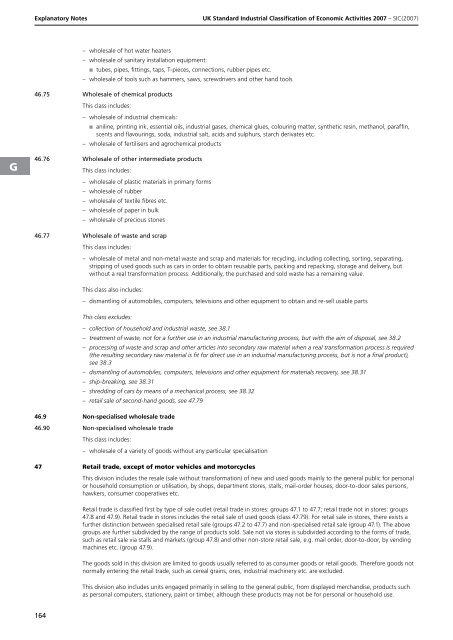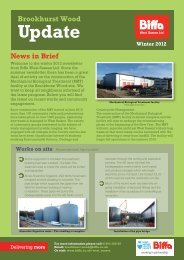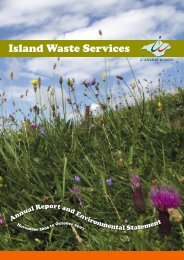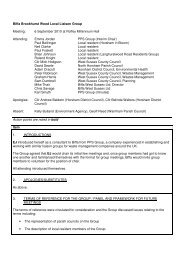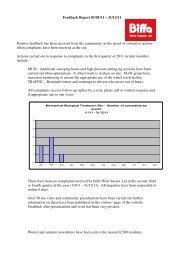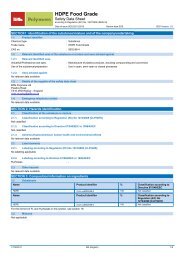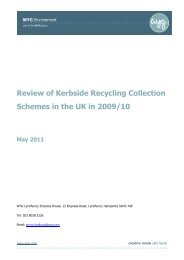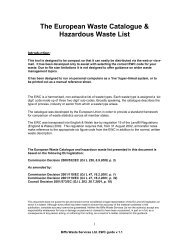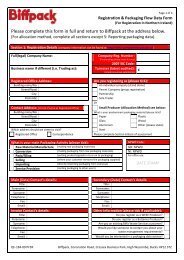detailed explanation for each SIC code - Biffa
detailed explanation for each SIC code - Biffa
detailed explanation for each SIC code - Biffa
Create successful ePaper yourself
Turn your PDF publications into a flip-book with our unique Google optimized e-Paper software.
Explanatory Notes<br />
UK Standard Industrial Classification of Economic Activities 2007 – <strong>SIC</strong>(2007)<br />
–<br />
–<br />
–<br />
wholesale of hot water heaters<br />
wholesale of sanitary installation equipment:<br />
■ tubes, pipes, fittings, taps, T-pieces, connections, rubber pipes etc.<br />
wholesale of tools such as hammers, saws, screwdrivers and other hand tools<br />
46.75 Wholesale of chemical products<br />
This class includes:<br />
–<br />
–<br />
wholesale of industrial chemicals:<br />
■ aniline, printing ink, essential oils, industrial gases, chemical glues, colouring matter, synthetic resin, methanol, paraffin,<br />
scents and flavourings, soda, industrial salt, acids and sulphurs, starch derivates etc.<br />
wholesale of fertilisers and agrochemical products<br />
G<br />
46.76 Wholesale of other intermediate products<br />
This class includes:<br />
– wholesale of plastic materials in primary <strong>for</strong>ms<br />
– wholesale of rubber<br />
– wholesale of textile fibres etc.<br />
– wholesale of paper in bulk<br />
– wholesale of precious stones<br />
46.77 Wholesale of waste and scrap<br />
This class includes:<br />
– wholesale of metal and non-metal waste and scrap and materials <strong>for</strong> recycling, including collecting, sorting, separating,<br />
stripping of used goods such as cars in order to obtain reusable parts, packing and repacking, storage and delivery, but<br />
without a real trans<strong>for</strong>mation process. Additionally, the purchased and sold waste has a remaining value.<br />
This class also includes:<br />
–<br />
dismantling of automobiles, computers, televisions and other equipment to obtain and re-sell usable parts<br />
This class excludes:<br />
–<br />
–<br />
collection of household and industrial waste, see 38.1<br />
treatment of waste, not <strong>for</strong> a further use in an industrial manufacturing process, but with the aim of disposal, see 38.2<br />
– processing of waste and scrap and other articles into secondary raw material when a real trans<strong>for</strong>mation process is required<br />
(the resulting secondary raw material is fit <strong>for</strong> direct use in an industrial manufacturing process, but is not a final product),<br />
see 38.3<br />
–<br />
–<br />
–<br />
–<br />
dismantling of automobiles, computers, televisions and other equipment <strong>for</strong> materials recovery, see 38.31<br />
ship-breaking, see 38.31<br />
shredding of cars by means of a mechanical process, see 38.32<br />
retail sale of second-hand goods, see 47.79<br />
46.9 Non-specialised wholesale trade<br />
46.90 Non-specialised wholesale trade<br />
This class includes:<br />
–<br />
wholesale of a variety of goods without any particular specialisation<br />
47 Retail trade, except of motor vehicles and motorcycles<br />
This division includes the resale (sale without trans<strong>for</strong>mation) of new and used goods mainly to the general public <strong>for</strong> personal<br />
or household consumption or utilisation, by shops, department stores, stalls, mail-order houses, door-to-door sales persons,<br />
hawkers, consumer cooperatives etc.<br />
Retail trade is classified first by type of sale outlet (retail trade in stores: groups 47.1 to 47.7; retail trade not in stores: groups<br />
47.8 and 47.9). Retail trade in stores includes the retail sale of used goods (class 47.79). For retail sale in stores, there exists a<br />
further distinction between specialised retail sale (groups 47.2 to 47.7) and non-specialised retail sale (group 47.1). The above<br />
groups are further subdivided by the range of products sold. Sale not via stores is subdivided according to the <strong>for</strong>ms of trade,<br />
such as retail sale via stalls and markets (group 47.8) and other non-store retail sale, e.g. mail order, door-to-door, by vending<br />
machines etc. (group 47.9).<br />
The goods sold in this division are limited to goods usually referred to as consumer goods or retail goods. There<strong>for</strong>e goods not<br />
normally entering the retail trade, such as cereal grains, ores, industrial machinery etc. are excluded.<br />
This division also includes units engaged primarily in selling to the general public, from displayed merchandise, products such<br />
as personal computers, stationery, paint or timber, although these products may not be <strong>for</strong> personal or household use.<br />
164


